Lumateperone Interact with S-Protein of Ebola Virus and TIM-1 of Human Cell Membrane: Insights from Computational Studies
Abstract
:Simple Summary
Abstract
1. Introduction
2. Materials and Methods
2.1. Protein 3D Structure Prediction
2.2. Ligand Selection
2.3. Drug Target Prediction
2.4. Molecular Dynamic Simulation
2.5. Protein–Protein Docking
2.6. Molecular Docking Analysis of S-Protein, TIM-1 with Lumateperone
2.7. Physiochemical Properties of Lumateperone
3. Results
3.1. Structural Modeling
3.2. Ligand Selection and Its Validation
3.3. Molecular Docking
3.3.1. Protein–Protein Docking
3.3.2. Protein–Substrate/Drug Docking
3.4. Molecular Dynamic Simulation of TIM-1 and Lumateperone Docked Complex
4. Discussion
5. Conclusions
Supplementary Materials
Author Contributions
Funding
Institutional Review Board Statement
Informed Consent Statement
Data Availability Statement
Acknowledgments
Conflicts of Interest
References
- Geisbert, T.W.; Hensley, L.E. Ebola virus: New insights into disease aetiopathology and possible therapeutic interventions. Expert Rev. Mol. Med. 2004, 6, 1–24. [Google Scholar] [CrossRef] [PubMed]
- Feldmann, H.; Klenk, H.-D. Marburg and Ebola viruses. Adv. Virus Res. 1996, 47, 1–52. [Google Scholar]
- Feldmann, H.; Jones, S.; Klenk, H.-D.; Schnittler, H.-J. Ebola virus: From discovery to vaccine. Nat. Rev. Immunol. 2003, 3, 677–685. [Google Scholar] [CrossRef] [PubMed]
- Mohan, G.S.; Ye, L.; Li, W.; Monteiro, A.; Lin, X.; Sapkota, B.; Pollack, B.P.; Compans, R.W.; Yang, C. Less is more: Ebola virus surface glycoprotein expression levels regulate virus production and infectivity. J. Virol. 2015, 89, 1205–1217. [Google Scholar] [CrossRef] [PubMed]
- Brunton, B.; Rogers, K.; Phillips, E.K.; Brouillette, R.B.; Bouls, R.; Butler, N.S.; Maury, W. TIM-1 serves as a receptor for Ebola virus in vivo, enhancing viremia and pathogenesis. PLoS Negl. Trop. Dis. 2019, 26, 13. [Google Scholar] [CrossRef]
- Jemielity, S.; Wang, J.J.; Chan, Y.K.; Ahmed, A.A.; Li, W.; Monahan, S.; Bu, X.; Farzan, M.; Freeman, G.J.; Umetsu, D.T. TIM-family proteins promote infection of multiple enveloped viruses through virion-associated phosphatidylserine. PLoS Pathog. 2013, 9, e1003232. [Google Scholar] [CrossRef]
- Muzammal, M.; Khan, M.A.; Mohaini, M.A.; Alsalman, A.J.; Hawaj, M.A.A.; Farid, A. In Silico Analysis of Honeybee Venom Protein Interaction with Wild Type and Mutant (A82V + P375S) Ebola Virus Spike Protein. Biologics 2022, 2, 45–55. [Google Scholar] [CrossRef]
- Powlesland, A.S.; Fisch, T.; Taylor, M.E.; Smith, D.F.; Tissot, B.; Dell, A.; Pohlmann, S.; Drickamer, K. A novel mechanism for LSECtin binding to Ebola virus surface glycoprotein through truncated glycans. J. Biol. Chem. 2008, 283, 593–602. [Google Scholar] [CrossRef]
- Buzon, M.J.; Seiss, K.; Weiss, R.; Brass, A.L.; Rosenberg, E.S.; Pereyra, F.; Yu, X.G.; Lichterfeld, M. Inhibition of HIV-1 integration in ex vivo-infected CD4 T cells from elite controllers. J. Virol. 2011, 85, 9646–9650. [Google Scholar] [CrossRef]
- Mercer, J.; Helenius, A. Vaccinia virus uses macropinocytosis and apoptotic mimicry to enter host cells. Science 2008, 320, 531–535. [Google Scholar] [CrossRef]
- Miller, E.H.; Obernosterer, G.; Raaben, M.; Herbert, A.S.; Deffieu, M.S.; Krishnan, A.; Ndungo, E.; Sandesara, R.G.; Carette, J.E.; Kuehne, A.I. Ebola virus entry requires the host-programmed recognition of an intracellular receptor. EMBO J. 2012, 31, 1947–1960. [Google Scholar] [CrossRef] [PubMed] [Green Version]
- Lee, H.-H.; Meyer, E.H.; Goya, S.; Pichavant, M.; Kim, H.Y.; Bu, X.; Umetsu, S.E.; Jones, J.C.; Savage, P.B.; Iwakura, Y. Apoptotic cells activate NKT cells through T Cell Ig-Like Mucin-Like–1 resulting in airway hyperreactivity. J. Immunol. 2010, 185, 5225–5235. [Google Scholar] [CrossRef] [PubMed]
- Celanire, S.; Poli, S. (Eds.) Small Molecule Therapeutics for Schizophrenia; Springer: Cham, Switzerland, 2015. [Google Scholar]
- Yang, J.; Yan, R.; Roy, A.; Xu, D.; Poisson, J.; Zhang, Y. The I-TASSER Suite: Protein structure and function prediction. Nat. Methods 2015, 12, 7–8. [Google Scholar] [CrossRef]
- Laskowski, R.A.; MacArthur, M.W.; Moss, D.S.; Thornton, J.M. PROCHECK: A program to check the stereochemical quality of protein structures. J. Appl. Crystallogr. 1993, 26, 283–291. [Google Scholar] [CrossRef]
- UniProt Consortium. UniProt: A hub for protein information. Nucleic Acids Res. 2015, 43, 204–212. [Google Scholar] [CrossRef] [PubMed]
- Douguet, D. e-LEA3D: A computational-aided drug design web server. Nucleic Acids Res. 2010, 38, W615–W621. [Google Scholar] [CrossRef]
- Antoine, D.; Olivier, M.; Vincent, Z. Swiss Target Prediction: Updated data and new features for efficient prediction of protein targets of small molecules. Nucleic Acids Res. 2019, 47, W357–W364. [Google Scholar]
- López-Blanco, J.R.; Aliaga, J.I.; Quintana-Ortí, E.S.; Chacón, P. iMODS: Internal coordinates normal mode analysis server. Nucleic Acids Res. 2014, 42, W271–W276. [Google Scholar] [CrossRef]
- Kozakov, D.; Hall, D.R.; Xia, B.; Porter, K.A.; Padhorny, D.; Yueh, C.; Vajda, S. The ClusPro web server for protein–protein docking. Nat. Protoc. 2017, 12, 255. [Google Scholar] [CrossRef]
- Gaillard, T. Evaluation of AutoDock and AutoDock Vina on the CASF-2013 benchmark. J. Chem. Inf. Model. 2018, 58, 1697–1706. [Google Scholar] [CrossRef]
- Available online: https://pubchem.ncbi.nlm.nih.gov/ (accessed on 10 January 2022).
- Pettersen, E.F.; Goddard, T.D.; Huang, C.C.; Couch, G.S.; Greenblatt, D.M.; Meng, E.C.; Ferrin, T.E. UCSF Chimera—A visualization system for exploratory research and analysis. J. Comput. Chem. 2004, 25, 1605–1612. [Google Scholar] [CrossRef] [PubMed]
- Dassault Systemes. BIOVIA, Discovery Studio Modeling Environment, Release 2017; Dassault Systèmes: San Diego, CA, USA, 2016. [Google Scholar]
- Laskowski, R.A.; Swindells, M.B. LigPlot+: Multiple ligand–protein interaction diagrams for drug discovery. J. Chem. Inf. Model. 2011, 51, 2778–2786. [Google Scholar] [CrossRef] [PubMed]
- Daina, A.; Michielin, O.; Zoete, V. SwissADME: A free web tool to evaluate pharmacokinetics, drug-likeness and medicinal chemistry friendliness of small molecules. Sci. Rep. 2017, 7, 42717. [Google Scholar] [CrossRef] [PubMed]
- Ogawa, H.; Miyamoto, H.; Nakayama, E.; Yoshida, R.; Nakamura, I.; Sawa, H.; Takada, A. Seroepidemiological prevalence of multiple species of filoviruses in fruit bats (Eidolon helvum) migrating in Africa. J. Infect. Dis. 2015, 212 (Suppl. 2), S101–S108. [Google Scholar] [CrossRef]
- Maslow, J.N. The cost and challenge of vaccine development for emerging and emergent infectious diseases. Lancet Glob. Health 2018, 6, e1266–e1267. [Google Scholar] [CrossRef]
- Kondratowicz, A.S.; Lennemann, N.J.; Sinn, P.L.; Davey, R.A.; Hunt, C.L.; Moller-Tank, S.; Meyerholz, D.K.; Rennert, P.; Mullins, R.F.; Brindley, M. T-cell immunoglobulin and mucin domain 1 (TIM-1) is a receptor for Zaire Ebolavirus and Lake Victoria Marburgvirus. Proc. Natl. Acad. Sci. USA 2011, 108, 8426–8431. [Google Scholar] [CrossRef]
- Vela, J.M. Repurposing sigma-1 receptor ligands for COVID-19 therapy? Front. Pharmacol. 2020, 11, 1716. [Google Scholar] [CrossRef]
- Diffley, J.F. Author’s overview: Identifying SARS-CoV-2 antiviral compounds. Biochem. J. 2021, 478, 2533–2535. [Google Scholar] [CrossRef]
- Székelyhidi, Z.; Pató, J.; Wáczek, F.; Bánhegyi, P.; Hegymegi-Barakonyi, B.; Ero, D.; László, O. Synthesis of selective SRPK-1 inhibitors: Novel tricyclic quinoxaline derivatives. Bioorg. Med. Chem. Lett. 2005, 15, 3241–3246. [Google Scholar] [CrossRef]
- Mpanju, O.M.; Towner, J.S.; Dover, J.E.; Nichol, S.T.; Wilson, C.A. Identification of two amino acid residues on Ebola virus glycoprotein 1 critical for cell entry. Virus Res. 2006, 121, 205–214. [Google Scholar] [CrossRef]
- Manicassamy, B.; Wang, J.; Jiang, H.; Rong, L. Comprehensive analysis of Ebola virus GP1 in viral entry. J. Virol. 2005, 79, 4793–4805. [Google Scholar] [CrossRef] [PubMed]
- Lee, J.E.; Fusco, M.L.; Hessell, A.J.; Oswald, W.B.; Burton, D.R.; Saphire, E.O. Structure of the Ebola virus glycoprotein bound to an antibody from a human survivor. Nature 2008, 454, 177–182. [Google Scholar] [CrossRef] [PubMed] [Green Version]
- Wang, J.; Manicassamy, B.; Caffrey, M.; Rong, L. Characterization of the receptor-binding domain of Ebola glycoprotein in viral entry. Virol. Sin. 2011, 26, 156–170. [Google Scholar] [CrossRef]
- Jain, S.; Martynova, E.; Rizvanov, A.; Khaiboullina, S.; Baranwal, M. Structural and functional aspects of Ebola virus proteins. Pathogens 2021, 10, 1330. [Google Scholar] [CrossRef] [PubMed]
- Carraway, K.L.; Hull, S.R. Cell surface mucin-type glycoproteins and mucin-like domains. Glycobiology 1991, 1, 131–138. [Google Scholar] [CrossRef]
- Jena, A.B.; Kanungo, N.; Nayak, V.; Chainy, G.B.N.; Dandapat, J. Catechin and curcumin interact with S protein of SARS-CoV2 and ACE2 of human cell membrane: Insights from computational studies. Sci. Rep. 2021, 11, 2043. [Google Scholar] [CrossRef]
- Modrof, J.; Mühlberger, E.; Klenk, H.D.; Becker, S. Phosphorylation of VP30 impairs Ebola virus transcription. J. Biol. Chem. 2002, 277, 33099–33104. [Google Scholar] [CrossRef] [Green Version]
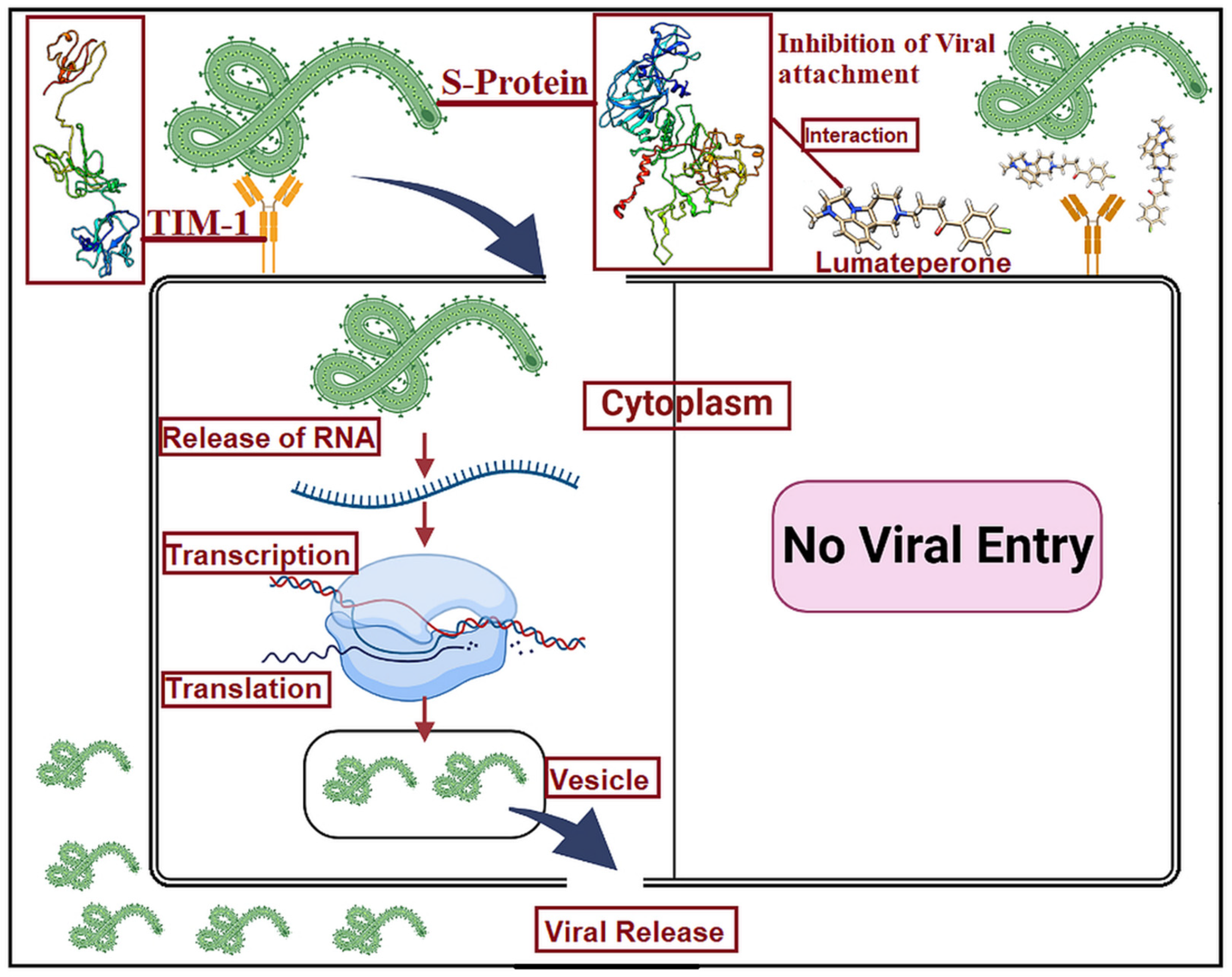

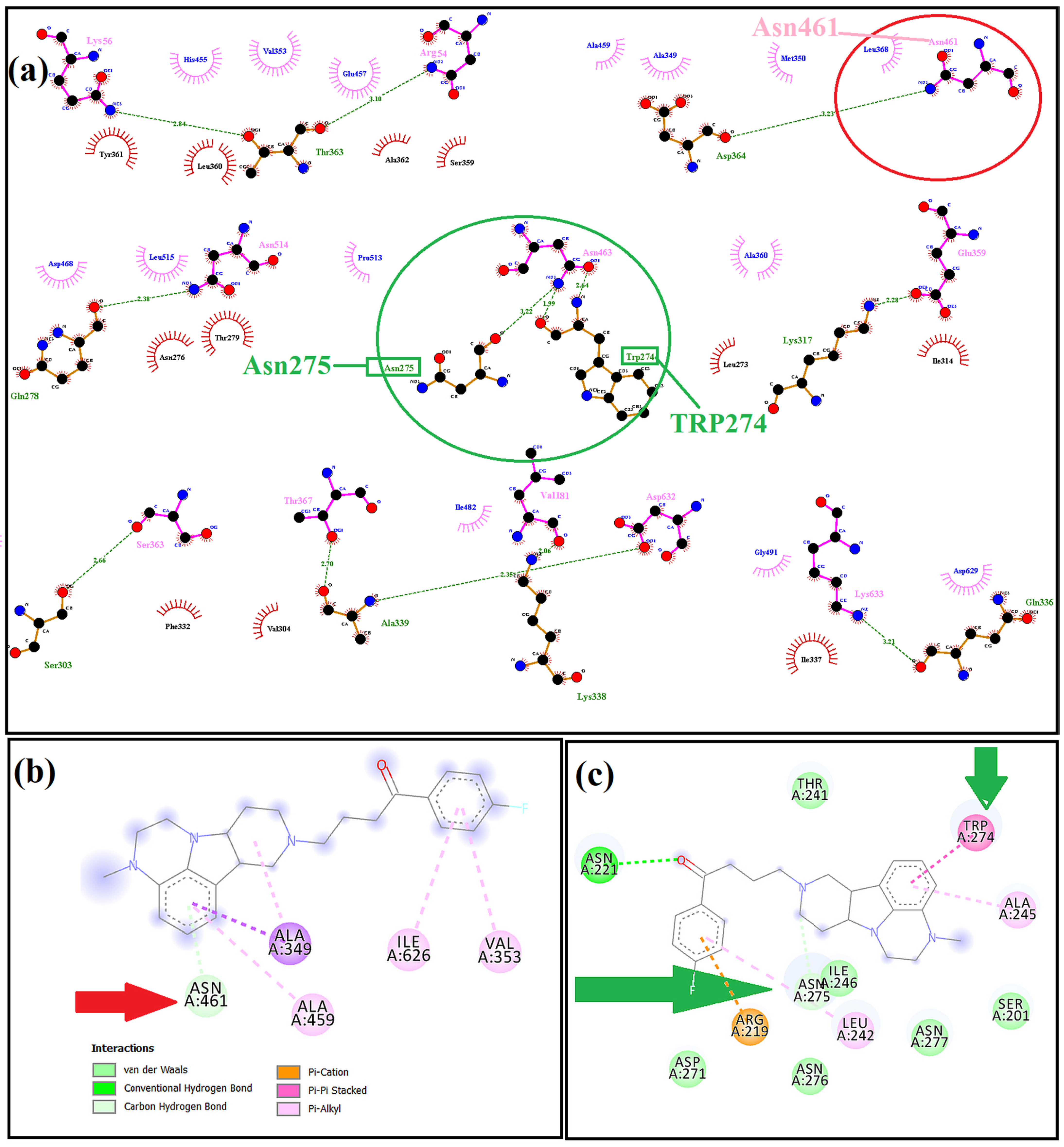
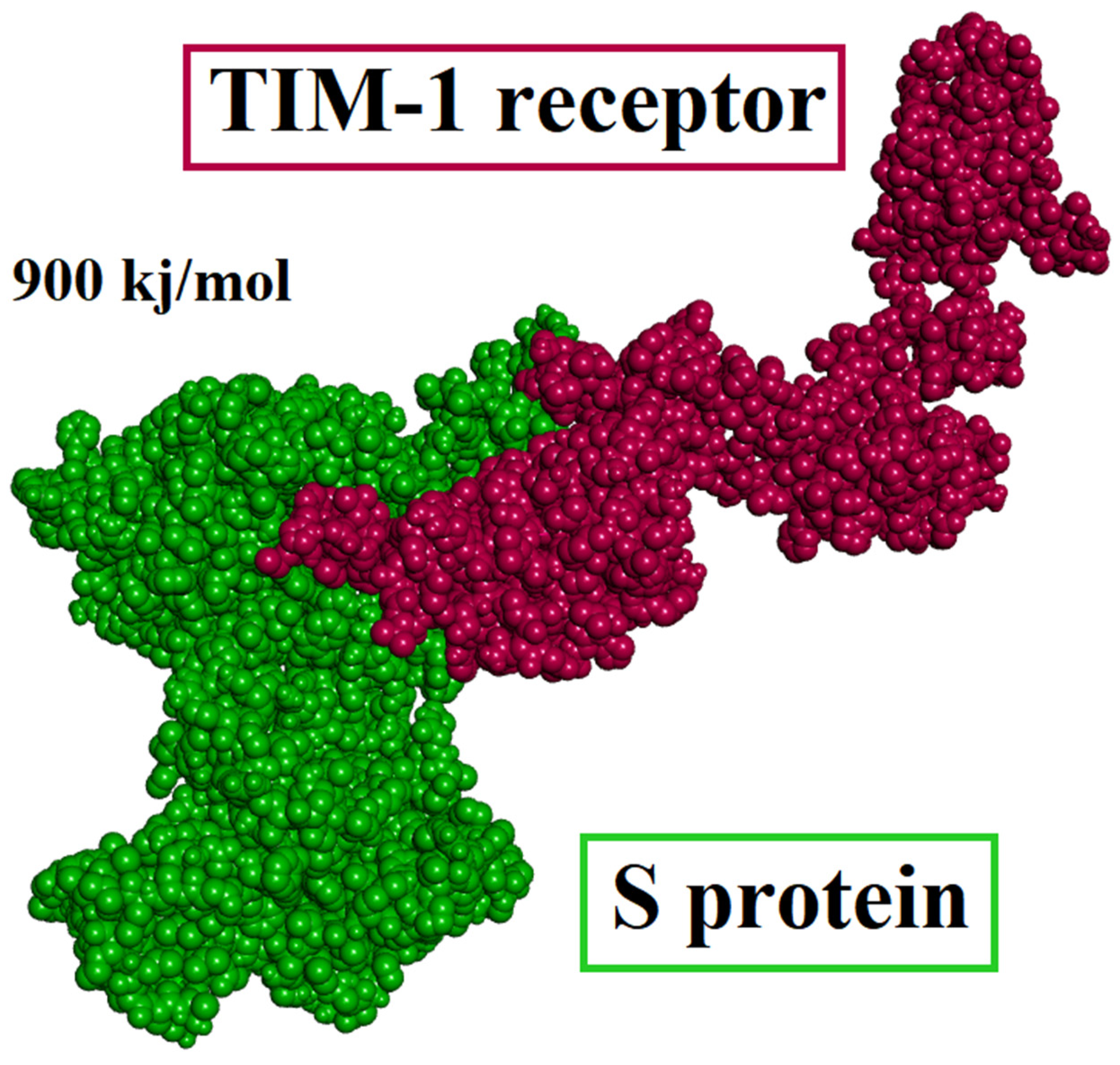
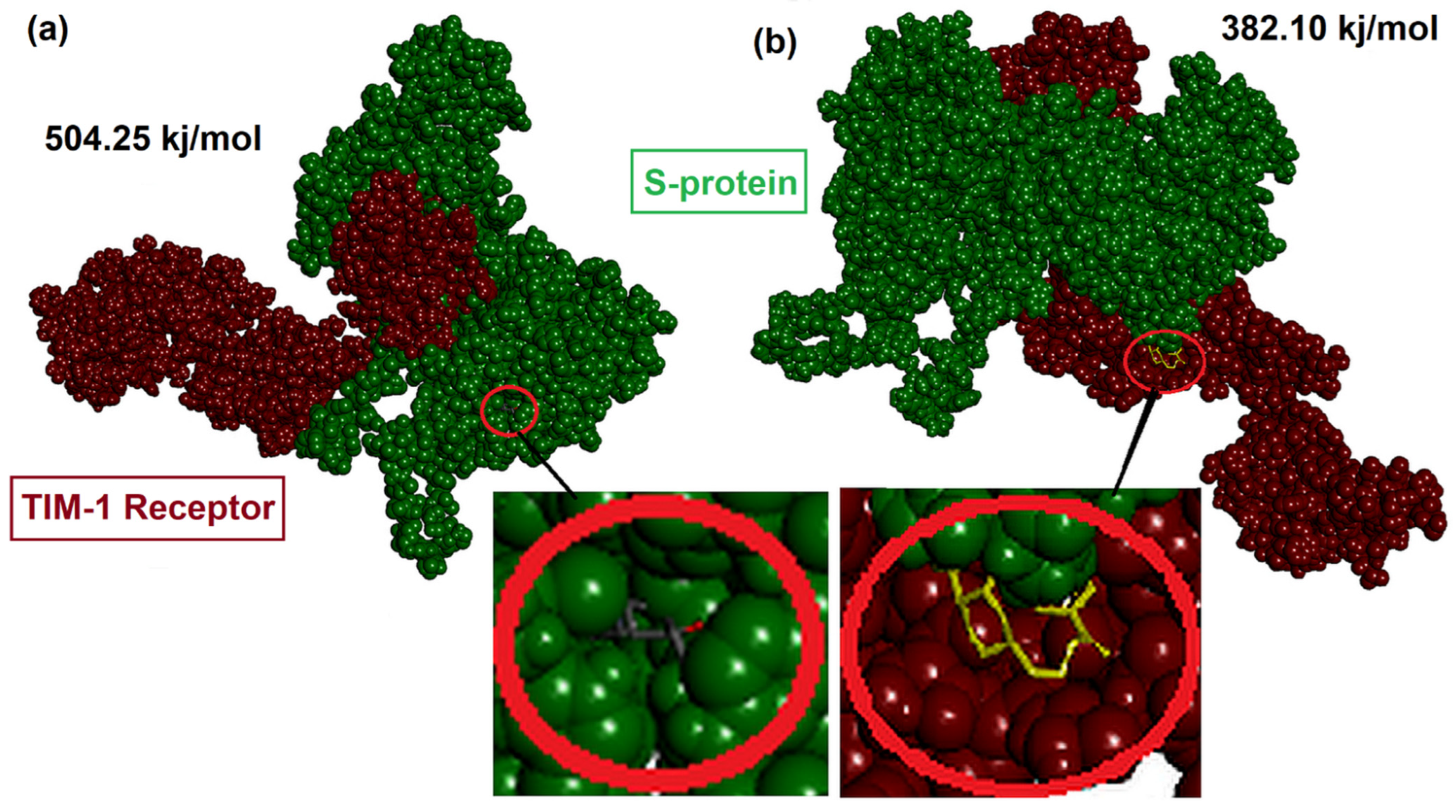
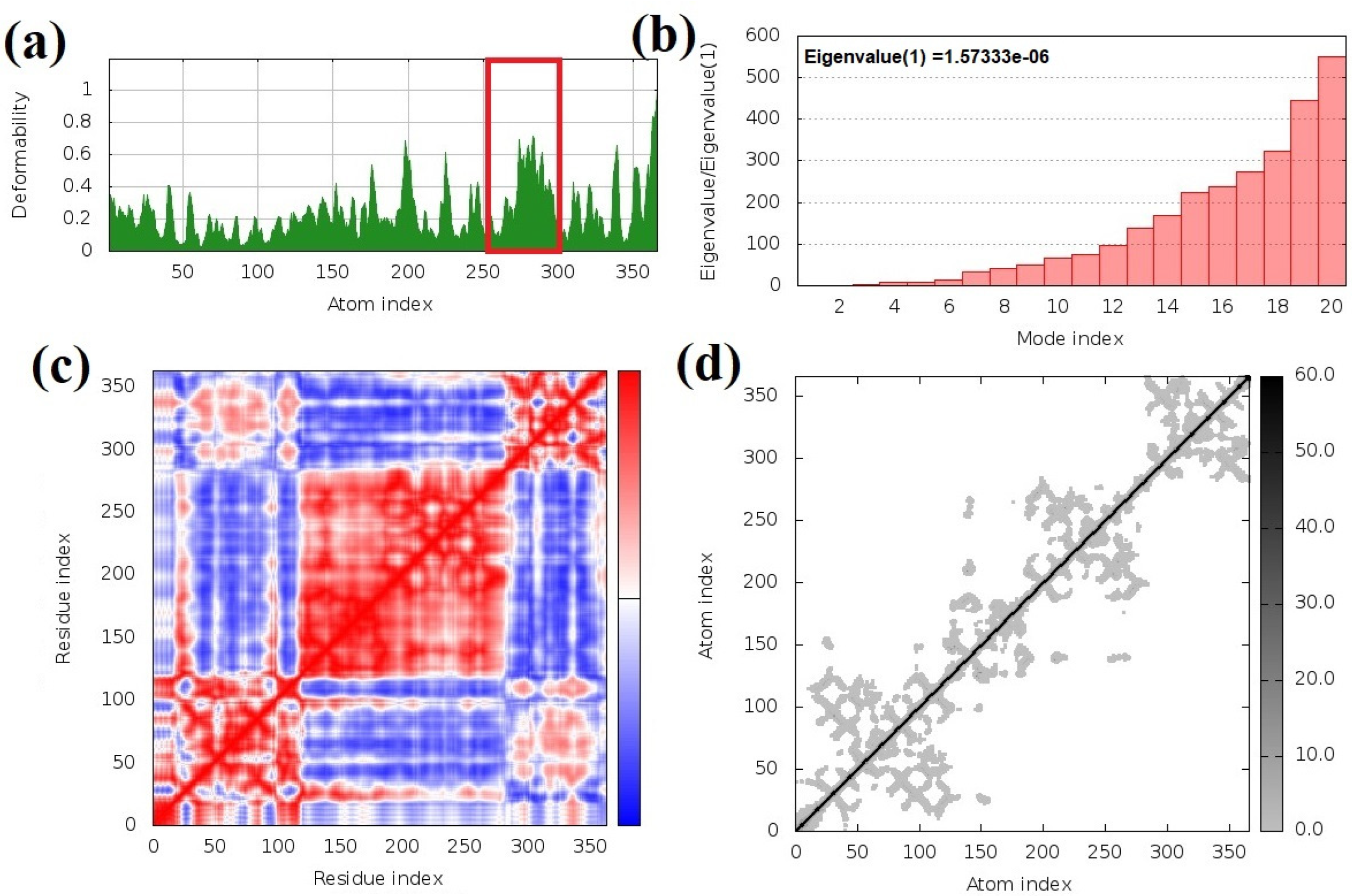
| Physiochemical Properties | Lipophilicity | ||
|---|---|---|---|
| Formula | C24H28FN3O | Log P o/w (LOGP value) | 3.68 |
| Molecular weight | 393.5 g/mol | Log P o/w (XLOGP3 value) | 3.77 |
| Number of heavy metal | 29 | Log P o/w (WLOGP value) | 3.19 |
| Number of aromatic heavy metal | 12 | Log P o/w (MLOGP value) | 3.43 |
| Fraction Csp3 | 0.46 | Log P o/w (SILICOS-IT value) | 3.71 |
| Number of rotatable bonds | 5 | Consensus Log P o/w | 3.56 |
| Number H bond accepters | 3 | Pharmacokinetics | |
| Number H bond donors | 0 | CYP2C19 inhibitor (Cytochrome P450 2C19 inhibitor) | No |
| Molar refractivity | 124.38 | CYP2C9 inhibitor (Cytochrome P450 2C9 inhibitor) | No |
| TPSA (topological polar surface area) | 26.79 A2 | CYP2D6 inhibitor (Cytochrome P450 2D6 inhibitor) | Yes |
| Consensus Log P o/w | 3.56 | CYP3A4 inhibitor (Cytochrome P450 3A4 inhibitor) | Yes |
| Water Solubility | Log Kp (skin permeation) | −6.02 cm/s | |
| Log S (ESOL) | −4.63 | CYP1A2 inhibitor (Cytochrome P450 1A2 inhibitor) | No |
| Solubility | 9.20 × 10−3 mg/mL; 2.34 × 10−5 mol/L | P-glycoprotein substrate | Yes |
| Class | Moderately soluble | Blood–Brain barrier permeant | Yes |
| Log S (Ali) | −4.03 | Gastrointestinal absorption | High |
| Solubility | 3.71 × 10−2 mg/mL; 9.42 × 10−5 mol/L | ||
| Class | Moderately soluble | ||
| Log S (SILICOS-IT) | −6.15 | ||
| Solubility | 2.78 × 10−4 mg/mL; 7.06 × 10−7 mol/L | ||
| Class | Poorly soluble | ||
| Receptor–Ligand Interaction | Type of Interaction | Interacting Residues |
|---|---|---|
| S-protein–Lumateperone | Pi-Donar Hydrogen Bond | Asn461 |
| Pi Sigma | Ala349 | |
| Alkyl | Ile626,Val353 | |
| Pi-Alkyl | Ala459 | |
| TIM-1 receptor–Lumateperone | Van der Waals | Thr241, Ile246, Asn277, Ser201, Asn276, Asp271 |
| Conventional Hydrogen Bond | Asn221 | |
| Carbon Hydrogen Bond | Asn275 | |
| Pi–Cation | Arg219 | |
| Pi–Pi stacked | Trp274 | |
| Pi–Alkyl Bond | Ala245 | |
| Protein–Protein Interaction (S-Protein/TIM-1) | Type of Interaction | Interacting Residues |
| S-protein residues | Hydrogen Bond Interaction | Lys56, Arg54, Asn461, Asn514, Asn463, Glu359, Ser363, Thr367, Val181, Asp632, Lys633, |
| TIM-1 receptor residues | Thr363, Asp364, Gln278, Asn275, Trp274, Lys317, Ser303, Ala339, Lys338, Gln336 |
| Lumateperone is docked to the S-protein | S-protein docking sites | TIM-1 receptor docking sites | Type and number of Bonds |
| Lys633, Leu481, Asp629, Asp632, Thr367, Glu472, Asn514 | Lys338, Gln336, Lys318, Ala339 His285, Gln278 | 5 hydrogen 2 unfavorable bond | |
| Lumateperone is docked to the TIM-1 protein | Gln567, Asp419 | Met 1, Thr155 | 2 hydrogen bonds |
Publisher’s Note: MDPI stays neutral with regard to jurisdictional claims in published maps and institutional affiliations. |
© 2022 by the authors. Licensee MDPI, Basel, Switzerland. This article is an open access article distributed under the terms and conditions of the Creative Commons Attribution (CC BY) license (https://creativecommons.org/licenses/by/4.0/).
Share and Cite
Muzammal, M.; Firoz, A.; Ali, H.M.; Farid, A.; Khan, M.A.; Hakeem, K.R. Lumateperone Interact with S-Protein of Ebola Virus and TIM-1 of Human Cell Membrane: Insights from Computational Studies. Appl. Sci. 2022, 12, 8820. https://doi.org/10.3390/app12178820
Muzammal M, Firoz A, Ali HM, Farid A, Khan MA, Hakeem KR. Lumateperone Interact with S-Protein of Ebola Virus and TIM-1 of Human Cell Membrane: Insights from Computational Studies. Applied Sciences. 2022; 12(17):8820. https://doi.org/10.3390/app12178820
Chicago/Turabian StyleMuzammal, Muhammad, Ahmad Firoz, Hani Mohammed Ali, Arshad Farid, Muzammil Ahmad Khan, and Khalid Rehman Hakeem. 2022. "Lumateperone Interact with S-Protein of Ebola Virus and TIM-1 of Human Cell Membrane: Insights from Computational Studies" Applied Sciences 12, no. 17: 8820. https://doi.org/10.3390/app12178820
APA StyleMuzammal, M., Firoz, A., Ali, H. M., Farid, A., Khan, M. A., & Hakeem, K. R. (2022). Lumateperone Interact with S-Protein of Ebola Virus and TIM-1 of Human Cell Membrane: Insights from Computational Studies. Applied Sciences, 12(17), 8820. https://doi.org/10.3390/app12178820






